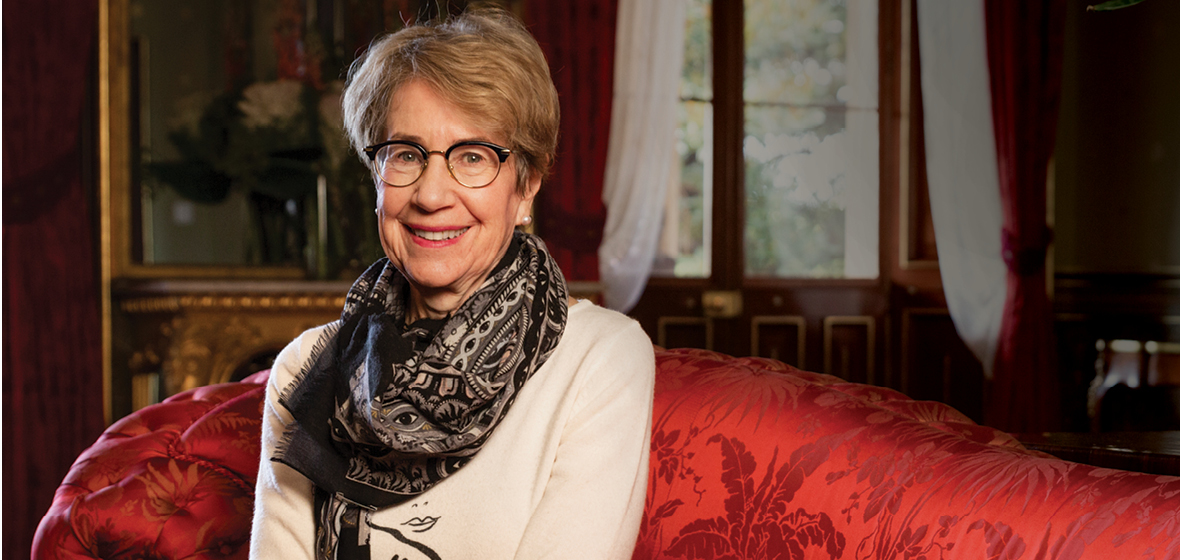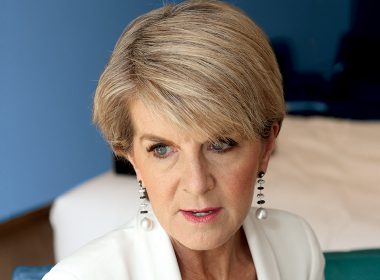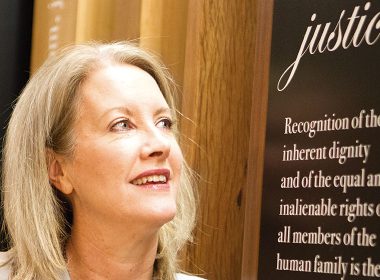To mark the two-year extension of Her Excellency the Honourable Margaret Beazley AC KC as Governor of NSW, we revisit this profile the Journal published in 2019, when the Governor was first appointed.
There are times in every journalist’s career when one must pull out all stops to impress their interview subject.
I’m acutely aware that a red carpet won’t cut it when I’m granted a sought-after interview with Her Excellency the Honourable Margaret Beazley AO QC, Governor of NSW, at her new abode in Sydney’s picturesque Government House. She’s the former President of the NSW Court of Appeal, an esteemed barrister, champion of women in law, a mother of three, enthusiastic yogi, and a shrewd wit to boot.
It seems only fitting to roll out the red pant suit.
The flamboyant outfit has inadvertently become a beacon for women in law – a symbol of Governor Beazley’s pioneering status and career as the first woman to sit on the NSW Court of Appeal bench between 1996 and 2019, and the first woman appointed President of that court.
Over 22 years, Beazley quietly and persistently blazed a trail for female lawyers to enter the male-dominated ranks of the judiciary. And she began with one audacious decision during her very first week in the Court of Appeal.
“I had heard there was a judge who didn’t believe in women wearing pants,” recalls Beazley. “I thought, ‘Well, bugger that!’ People don’t tell you what to wear. People don’t tell you what to do.
“So, I wore a red pant suit to our very first judges meeting.”
Beazley first aired this story in public at her swearing-out ceremony at Banco Court in Sydney’s Law Courts building in February this year. She grins as she is prompted to recount it now – I have arrived at Government House in a tailored crimson number from colourful British designer Johnnie Boden. And yes, I purchased it specifically in her former Honour’s honour.
Fortunately, the former judge concurs with my outfit decision: the red suit gets a green light.
“I don’t mind the silent protest,” Governor Beazley smiles. “And sometimes you have to do more than a silent protest. I don’t decry people who take a stance on things. But I think you have to pick your moment.”
I’m sure gender was a barrier throughout my career, but my approach was to go and do it [whatever it was] regardless.
It seems ironic that the 39th Governor of NSW might shy away from loud protest or fuss, especially given the pomp and ceremony that now punctuates her days at Government House. As the Queen’s representative in NSW, Her Excellency is regularly called upon to present honours and awards, to host community functions, luncheons and dinners, and to welcome important foreign dignitaries.
Her new digs are suitably swish for such royal occasions. We meet for our interview on the plush red lounges of the House drawing room – chandeliers, high ceilings and gold plating everywhere – with a fire crackling in the background on a chilly winter morning.
Tea is served: NSW-grown Madura leaves brewed in individual teapots, adorned with St Edward’s Crown and tinkled into china cups and saucers by Head Waiter Marcello. The Governor declines an iced shortbread biscuit – she prefers savoury over sweet treats, although House kitchen staff tell me food is often an afterthought for this constantly on-the-go woman. A soy cappuccino (for the caffeine-addled journalist) comes with a powdered chocolate crown shaken delicately into the foam.
It’s a world away from Beazley’s relatively modest childhood. She grew up in Sydney’s south west and went to a Catholic high school, Mount St Joseph in Milperra, where she says the teaching nuns were “foundational” in developing her lifelong appreciation for education.
“We were turned from 16 year olds who didn’t know what we wanted to do, let alone what we could, into young adults who were taught to think, to question, challenge and to do,” Beazley said at her swearing-out ceremony in February.
Beazley doesn’t remember having a strong passion for argument as a child, though she undoubtedly learned to stand her ground as the middle sibling of five. A self-professed tomboy, some of her fondest memories are of climbing trees around her local streets in Hurstville.
Her parents lived through the Great Depression of the 1930s and her father worked as a milkman to support his family, so the Beazleys never had much. Her parents had little high school education and no opportunity to attend university. At her swearing-out ceremony, Governor Beazley called them “essentially uneducated but so intelligent”.
I ask what her late parents would think of the lavish setting in which we are now sipping tea, under the watchful glare of Queen Elizabeth II beaming across Government House drawing room from a gold-plated picture frame.
“Oh, they would be over the moon,” Beazley says. “I have a photograph of my parents – I think it was taken when I was sworn in – and one of my daughters said, ‘Just look at Pop. He’s so proud’.”

Workload was a huge challenge. People would ask, ‘How do you manage it all?’ And I would say, look, so long as the peanut butter went between the slices of bread and not between the pages of the judgment I figured I was ahead.
Very few women attended university when Governor Beazley first dived into legal textbooks at the University of Sydney law school in 1970. Even fewer graduated as solicitors. Beazley was one of a small number of women who graduated from the law school in 1974, and she was only the 37th woman in NSW to be admitted to the Bar the very next year.
She was the first woman in history to be appointed a full-time judge in the Federal Court of Australia, and she is only the second woman to hold the title of Governor of NSW.

Of course, there were myriad challenges along the way. One of them was a prevailing view that women lawyers should only practise family law.
“It was the thing that annoyed me most as a young lawyer,” says Beazley. “I had all these barristers telling me, ‘Oh dear, dear, dear, if you want to become a barrister go ahead and join those barristers in family law. Don’t bother coming ‘round to our chambers.’
“But I didn’t want to do family law. I wanted to do the commercial law subjects and equity that I loved at law school.”
Even David Jones had difficulty with the concept of a female barrister. When Beazley became the only woman barrister on the ninth floor of Selbourne Chambers, the department store refused to tailor a female bar jacket for her to wear under her robes. So she didn’t bother wearing one until she was promoted to Queen’s Counsel in 1989.
“I’m sure gender was a barrier throughout my career, but my approach was to go and do it [whatever it was] regardless,” says Beazley. “I think that people have a right and entitlement to do what they want to do according to their abilities. That’s what I’ve always done. I talk to a lot of young people in these terms – be a doer. Do what you want to do.”

And Beazley’s career involved plenty of doing.At the same time as she was building a busy commercial practice at the Bar, Beazley was appointed to the NSW Equal Opportunity Tribunal in 1984. She then served as Acting Judge of the District Court of NSW and as Assistant Commissioner of the NSW Independent Commission Against Corruption (ICAC) in the early 1990s. While on the Federal Court bench, she was a member of its Gender Awareness Committee. And from 1994 to 1995, Beazley was a consultant to the Australian Law Reform Commission’s ground-breaking report on “Gender Bias and the Law”.
Governor Beazley was awarded an officer of the Order of Australia in 2006 for her unfaltering service to the judiciary and the law. Somehow, between it all, she found time to raise three children.
“Workload was a huge challenge,” Beazley admits. “People would ask, ‘How do you manage it all?’ And I would say, look, so long as the peanut butter went between the slices of bread and not between the pages of the judgment I figured I was ahead.”
Despite smashing glass ceilings at every corner, Beazley is reluctant to call herself a feminist.
“I’m not big on labels generally,” she explains.
She laughs when I point out the irony that various honorifics and titles have plagued her career – Queen’s Counsel, Commissioner, Judge, and now Governor.
“I understand the power structures that feminist theorists talk about and I resist those,” the Governor continues. “I talk about those things and I talk, hopefully, strongly and sensibly about those things. But I don’t have a background in feminist theory.
“I had an amusing experience where I was driving my daughter to school with her friends and they were doing an assignment. There was all this chatter in the back. My daughter said to me, ‘Mum, are we up to the second or third wave of feminism?’
I said, ‘Darling, I didn’t think we got through the first stage!’”

ALTHOUGH gender bias and all that goes with it, including sexism, harassment and bullying, was a part of Governor Beazley’s experience at the Bar, she says she never encountered it among her judicial colleagues. She’s aware of the data – that approximately half of all women lawyers and one third of men have been bullied at work, according to a 2018 survey of 7,000 lawyers globally by the International Bar Association. The rates of harassment among lawyers are similarly shocking. But Governor Beazley says there was no air for such ugly behaviour on the bench. She believes pay equity had a huge role to play in that.
“All judges on the same bench are on the same pay, and I think that has a significant impact,” she says. “There’s a slight difference between what the Chief Justice is paid and also for the President of the Court of Appeal, but apart from that we were all being paid the same. When equal pay is part of the package, it becomes part of the ethos. Money has a power aspect to it that you can’t ignore.”
The pay gap – which sits at 26.2 per cent across the broader Australian legal profession, according to the Women’s Gender Equality Agency – may be irrelevant between judges at the same level, but the numbers of female judges are still lagging behind men in NSW.
Only 10 of the 52 judges in the NSW Supreme Court and Court of Appeal are women. Women make up 38.5 per cent of the total judiciary in NSW. I note it was only six years ago that Governor Beazley was appointed the first female President of the Court of Appeal – why did it take so long for a woman to be granted that opportunity?
“You do wonder why it has taken so long – I don’t really have the answers for that,” she replies. “After I was appointed to the Court of Appeal, it took 10 years for another female to be appointed.
“I will say there has been a significant increase in the number of women appointed to the bench in the time since I started. Certainly, there is now more of a keen eye to maintaining that balance.”
Speaking of balance, the Governor has a lot more time for it these days. She’s free from parental duties now that her children are grown up and flourishing in their careers (none of them in law, she says – “they literally fled the scene”).
The 67 year old took up yoga late in her judicial career and still attends weekly sessions with her former colleagues in the Supreme Court building every Friday afternoon. She also goes to Wednesday morning classes at Sydney’s Tattersalls Club before hustling back to preside over Executive Council meetings at 8.30am. She rises early most days – perhaps a habit carried over from her days at the bar and bench – and if there’s no yoga she fits in a brisk walk through the Botanic Gardens for exercise.
If all else fails, the Governor clocks an impressive number of steps navigating her extravagant new abode.
“Government House is so large – it is a wonderful way to get your daily exercise,” she laughs.
She demonstrates this by bounding spritely up and down the main staircase as we scout photo locations.
Governor Beazley’s energy is infectious. It holds promise for the worthy goals she wants to focus on during her time as head of the Executive arm of NSW.
“I want to focus on juvenile justice, and I want to focus on education,” Beazley says, with a nod to the many doors her schooling and university degree opened for her.
Her eyes sparkle when she divulges her third goal – it is one she has carried from her earliest days in law school libraries to the highest bench of the NSW court system.
“I still do maintain a very deep belief in the rule of law,” she says. “You can’t have a working society unless there is a widespread belief in the rule of law, but that requires a proper understanding of what it means.
“So, to the extent that I will have occasions to speak about the rule of law and help people to understand it, I will try to solidify that civic construct. By talking about those sorts of things, I think it adds to a strong community.”

Update: Her Excellency the Honourable Margaret Beazley AC KC agreed to a two-year extension as Governor of NSW, Premier Chris Minns confirmed.
“Her Excellency has agreed to continue in her role as Governor of New South Wales for an additional two-year period.” Minns said.
“She has a deep commitment and dedication to the office she holds and the people of NSW who she serves.”
Her Excellency was appointed as the 39th Governor of New South Wales on 2 May 2019.
Her term has been extended to 1 May 2026.




